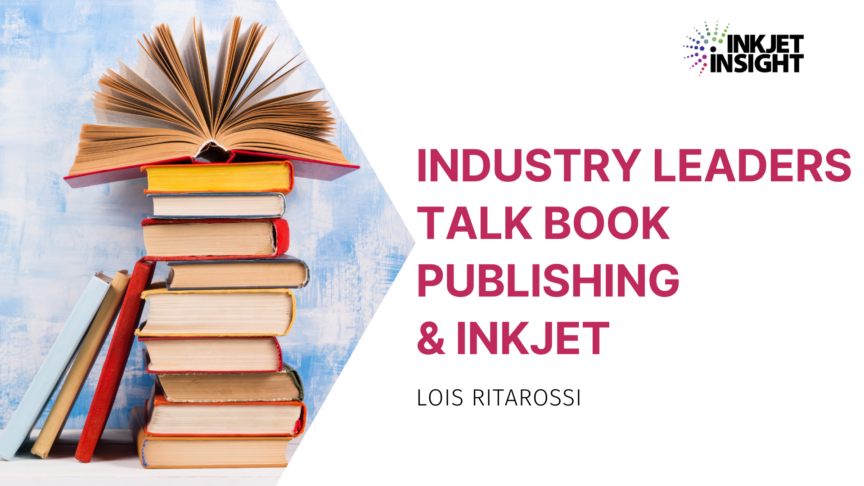Book publishing in North America is dominated by 5 large companies who control 80% of the books printed. Globally, there are 15 publishers who control similar percentages. These large publishers have business practices for book printing and distribution dating back to the pre-digital world, and some have been following unchanged practices for well over 100 years. So where does inkjet fit in the book printing industry?
To provide perspective on the impact of inkjet in book printing, I recently spoke with two industry leaders. Brooke Warner, the Publisher of She Writes Press and SparkPress. She Writes Press, is an independent publisher providing authors a hybrid model between traditional publishing and self-publishing. I also met with Kevin Spall, Senior Vice President of Global Planning, Manufacturing and Procurement at Scholastic. Scholastic is one of the top 10 publishers globally, and the largest publisher of children’s books. Kevin and his team are responsible for manufacturing and distribution of books, magazines, catalogs and educational products.
Book Business
Brooke shared her perspective on the resistance to change in an industry dominated by a handful of large publishers with long standing business practices.
To get from a manuscript to books on shelves, the logistical demands of timely shipping, handling, and delivery of heavy products across the country presents many challenges. The ingrained business practices of publishers accepting book returns and the over-printing philosophy to get to lower cost per book, have inhibited production from migrating to digital print. Book printers with fully depreciated offset equipment have different cost models for variable and fixed cost compared to inkjet platforms.
Hard to change hardcover glamor
Hardcover books still carry prestige and preference over softcover books. Some publishers offer authors incentives for hardcover books. Yet, hardcover binding is labor intensive, costly, and creates more waste than softcover production. Brooke is an advocate for changes in publishing. Especially those changes that will have a positive environmental and cost impact. She admits it’s an uphill battle to change mindset around softcovers replacing hardcover bindery. Even in the face of wide acceptance by consumers, including for library editions.
Short run vs. Long run
Brooke acknowledged the desire to move more production to print-on-demand (POD) using inkjet. POD is more efficient and creates less environmental waste. Authors agree that inkjet production meets their image quality standards and is beneficial in achieving on time publication dates. Short runs may make the most sense when calculating how many books will sell. Yet, authors and large publishers often prefer longer runs to have books in warehouses, while enduring the financial impact of steep discounts and returned books.
Logistics drive digital strategy
For Scholastic, digital production, primarily with inkjet, has been a successful tool for supply chain and planning teams in dealing with the recent paper and labor challenges. The manufacturing, planning, and forecasting teams, now use digital production daily across their 20 US-based print partners to manage orders to meet publication dates. Without digital and inkjet printing, they would have far greater stock outs impacting their customers.
Up until 2019, all Scholastic printing was run on traditional offset equipment with long run planning. Kevin implemented a digital strategy to address time to market and stock outages. Some production initially moved to toner digital devices. This digital strategy has transitioned to printing book blocks on inkjet devices with HD inks, with 4-color covers printed on toner devices. Digital production represents a small portion of Scholastic’s overall print, but with inkjet at the core, digital is growing at 30-40% per year.
With runs of 3,000 books or less, inkjet production is an easy decision for Scholastic. The planning team looks closely at delivery dates and unit cost per book in determining inkjet over offset. With ongoing paper supply challenges, they may choose inkjet – even at a higher unit cost – to meet delivery dates or conserve paper. Scholastic supplies paper for offset jobs and their print partners supply the paper for inkjet production.
No press time available
The pandemic caused book printing volumes to decline in 2020. But in 2021, volumes across most segments re-bounded, and publishers are predicting healthy growth for 2022. With this growth, book printers now have paper supply challenges and a larger number of orders to manufacture. Six-to-eight-week lead times have stretched to 16 weeks. Most major book printers are experiencing fully committed production schedules into the 2nd and 3rd quarter of 2022. It’s a new challenge for the printers to say “No, we can’t accept your job for months.” Or worse, requiring publishers to book their production time slot now, or not get one until the 4th quarter.
Several traditionally offset book printers have added inkjet capabilities to expand their offerings and shorten manufacturing time. Publishers will need to leverage digital and inkjet to meet market demands for new titles. Inkjet production runs will get titles to market faster, while longer offset runs will fill the warehouses for subsequent orders. 2022 might be the inkjet year for book printing.

